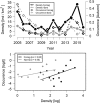Circumpolar status of Arctic ptarmigan: Population dynamics and trends
- PMID: 31073984
- PMCID: PMC6989701
- DOI: 10.1007/s13280-019-01191-0
Circumpolar status of Arctic ptarmigan: Population dynamics and trends
Abstract
Rock ptarmigan (Lagopus muta) and willow ptarmigan (L. lagopus) are Arctic birds with a circumpolar distribution but there is limited knowledge about their status and trends across their circumpolar distribution. Here, we compiled information from 90 ptarmigan study sites from 7 Arctic countries, where almost half of the sites are still monitored. Rock ptarmigan showed an overall negative trend on Iceland and Greenland, while Svalbard and Newfoundland had positive trends, and no significant trends in Alaska. For willow ptarmigan, there was a negative trend in mid-Sweden and eastern Russia, while northern Fennoscandia, North America and Newfoundland had no significant trends. Both species displayed some periods with population cycles (short 3-6 years and long 9-12 years), but cyclicity changed through time for both species. We propose that simple, cost-efficient systematic surveys that capture the main feature of ptarmigan population dynamics can form the basis for citizen science efforts in order to fill knowledge gaps for the many regions that lack systematic ptarmigan monitoring programs.
Keywords: Arctic; Climate change; Ecosystems; Lagopus spp.; Population cycles; Transient dynamics.
Figures




References
-
- Buckland ST, Anderson DR, Burnham KP, Laake JL, Borchers DL, Thomas L. Introduction to distance sampling. Estimating abundance of biological populations. New York: Oxford University Press, Inc.; 2001.
MeSH terms
LinkOut - more resources
Full Text Sources
Miscellaneous

